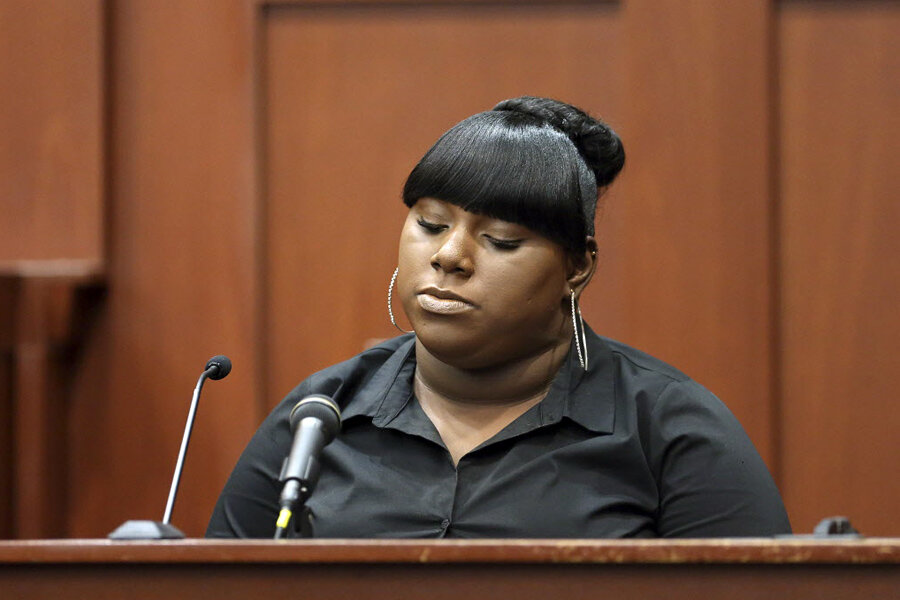'Boy's voice' called for help, testifies eyewitness in Trayvon Martin case
| Sanford, Fla.
In arguably the boldest testimony yet in the trial of George Zimmerman for the murder of Florida teenager Trayvon Martin, three witnesses – including a friend who was talking to Trayvon on the phone – on Wednesday described a scene in which they believe a boy was yelling for help while being attacked by a larger and “dominant” man.
Rachel Jeantel, 19, cried on the stand as she described Trayvon saying on the phone that he was being followed by a “creepy ass cracker” and then, a bit later, overheard him saying, “Why are you following me for?" “Then I heard a hard-breathing man say, 'What are you doing around here?' ” Ms. Jeantel testified. After hearing a “bump,” she said she heard Trayvon say, "Get off, get off,” before the phone disconnected.
Two eyewitnesses, meanwhile, said they thought Trayvon cried out for help during a struggle on the sidewalk.
“I felt like it was the boy’s voice,” Jayne Surdyka told jurors about the deadly scene that unfolded on a rainy February night last year in her Sanford, Fla., neighborhood.
If true, those statements appear to contradict Mr. Zimmerman’s story, which is that an unarmed young black man, whom the world came to know as Trayvon Martin, attacked him, broke his nose, bashed his head, tussled for his gun – all before Zimmerman found his 9mm pistol and fired once, killing Trayvon almost instantly.
Police in Sanford, Fla., let Zimmerman go without charges, saying his claims of self-defense could not be countered. Zimmerman was indicted 44 days later by a special state prosecutor, whose assistants are now in the unusual position of proving that local police made the wrong call given the evidence at the scene. Zimmerman faces a second-degree murder charge for pursuing and confronting an unarmed teenager, who then ended up dead. He faces the possibility of spending the rest of his life in state prison.
The case has divided America along racial and cultural lines. Many Americans believe Zimmerman acted in the role of a criminal vigilante by pursuing an innocent young black teenager without any evidence he’d done anything wrong, and against the advice of a nonemergency police dispatcher.
Others point to evidence – including photos of Zimmerman with a broken nose and cuts on the back of his head – that suggests that Trayvon was the aggressor. Social media postings indicating that Trayvon smoked pot and talked about guns and martial arts fighting, Zimmerman’s defenders say, raise questions about whether Trayvon in fact targeted Zimmerman and put him in a position where he had to defend himself with deadly force. “You’re going to die tonight,” Zimmerman told police Trayvon said as he was beating him up.
That story, however, seemed to contradict testimony on Wednesday by Ms. Surdyka and another neighbor, Jeannee Manalo.
Ms. Manalo said she thought Zimmerman was astride Trayvon during a violent struggle. But she also said it was too dark to see exactly what was going on, and she made the judgment about who was the aggressor by looking at photos of Zimmerman and Trayvon afterward. She said she still believed she saw Zimmerman “hitting down” on a prone Trayvon.
Surdyka testifed she heard from her second-floor window two loud voices, including an “aggressive voice” and a voice that belonged to “a boy.”
"I could see two people on the ground, one on top of each other," Surdyka said, acknowledging that the dark and rain precluded her from seeing clearly the people “wrestling or shuffling” near her house.
Then she said she heard two cries for help. "They were excruciating," she testified. "I felt like it was the boy's voice."
The testimony is the best analysis jurors may get of the manic struggle. Judge Debra Nelson barred state prosecutors from calling two expert witnesses who had pegged the pleading voice as Trayvon's. Other experts said those conclusions were drawn from methods that are not widely accepted in the audio analysis community.
Defense attorneys Mark O’Mara and Don West noted on cross-examination that Surdyka may have mistook what happened, because Zimmerman has said he got on top of Trayvon after shooting the boy. They asked Manalo why she hadn’t drawn such a definite conclusion in testimony to police, and they had her read a portion of previous testimony in which she said she could identify only “shadows.”
Jeantel also acknowledged previously lying about her age as well as about the reason she didn't attend Trayvon's funeral, saying she didn't want to become part of the public story.
On Wednesday, the jury also heard a series of taped 911 calls Zimmerman had previously made to police regarding his neighborhood-watch duties at the Retreat at Twin Lakes in Sanford. He had called more than 50 times in an eight-year span, but the five calls played to the jury included a segment in which he identifies himself as a neighborhood watch captain and describes suspicious black men near a garage. In another call, he urged the police to respond right away because the suspects “typically get away quickly.”
Judge Nelson this week warned prosecutors to refrain from using the phrase “racial profiling” when talking about Zimmerman’s actions. But the issue of racial stereotyping and injustice has dominated national debate about the case, though those complaints are complicated by Zimmerman’s own multi-ethnic heritage and indications that Zimmerman weighed other factors when deciding to get out of his car to take a closer look at Trayvon. Neighborhood watch groups expressly forbid watch members from pursuing suspects by themselves.
Six women – five of them mothers – make up the jury in the case. An alternate juror, a male arm-wrestler, was dismissed Wednesday for personal reasons.







